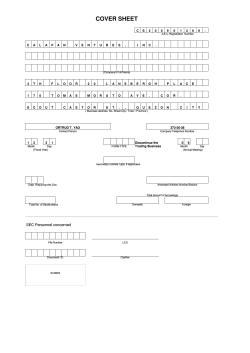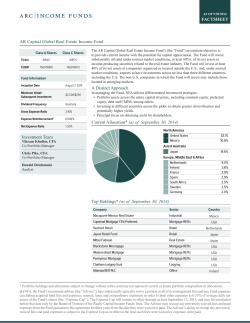
Introduction Chapter One McGraw-Hill/Irwin
Chapter One Introduction McGraw-Hill/Irwin Copyright © 2012 by The McGraw-Hill Companies, Inc. All rights reserved. Why study Financial Markets and Institutions? Markets and institutions are primary channels to allocate capital in our society Proper capital allocation leads to growth in: Societal Wealth Income Economic opportunity 1-2 Why study Financial Markets and Institutions? In this text we will examine: the structure of domestic and international markets the flow of funds through domestic and international markets an overview of the strategies used to manage risks faced by investors and savers 1-3 Financial Markets Financial markets are one type of structure through which funds flow Financial markets can be distinguished along two dimensions: primary versus secondary markets money versus capital markets 1-4 Primary versus Secondary Markets Primary markets markets in which users of funds (e.g., corporations and governments) raise funds by issuing financial instruments (e.g., stocks and bonds) Secondary markets markets where financial instruments are traded among investors (e.g., NYSE and Nasdaq) 1-5 Primary versus Secondary Markets 1-6 Primary versus Secondary Markets Do secondary markets add value to society or are they simply a legalized form of gambling? How does the existence of secondary markets affect primary markets? 1-7 Money versus Capital Markets Money markets markets that trade debt securities with maturities of one year or less (e.g., CDs and U.S. Treasury bills) little or no risk of capital loss, but low return Capital markets markets that trade debt (bonds) and equity (stock) instruments with maturities of more than one year substantial risk of capital loss, but higher promised return 1-8 Money Market Instruments Outstanding, ($Bn) 1-9 Capital Market Instruments Outstanding, ($Bn) 1-10 Foreign Exchange (FX) Markets FX markets Spot FX trading one currency for another (e.g., dollar for yen) the immediate exchange of currencies at current exchange rates Forward FX the exchange of currencies in the future on a specific date and at a pre-specified exchange rate 1-11 Derivative Security Markets Derivative security a financial security whose payoff is linked to (i.e., “derived” from) another security or commodity, generally an agreement to exchange a standard quantity of assets at a set price on a specific date in the future, the main purpose of the derivatives markets is to transfer risk between market participants. 1-12 Derivative Security Markets Selected examples of derivative securities Exchange listed derivatives Many options, futures contracts Over the counter derivatives Forward contracts Forward rate agreements Swaps Securitized loans 1-13 Derivatives and the Crisis 1. Mortgage derivatives allowed a larger amount of mortgage credit to be created in the mid-2000s. 2. Mortgage derivatives spread the risk of mortgages to a broader base of investors. 3. Change in banking from ‘originate and hold’ loans to ‘originate and sell’ loans. Decline in underwriting standards on loans 1-14 Derivatives and the Crisis 1. 2. Subprime mortgage losses have been quite large, reaching over $700 billion. The “Great Recession” was the worst since the “Great Depression” of the 1930s. Trillions $ global wealth lost, peak to trough stock prices fell over 50% in the U.S. Lingering high unemployment in the U.S. Sovereign debt levels in developed economies at alltime highs 1-15 Financial Market Regulation The Securities Act of 1933 full and fair disclosure and securities registration The Securities Exchange Act of 1934 Securities and Exchange Commission (SEC) is the main regulator of securities markets 1-16 Financial Institutions (FIs) Financial Institutions institutions through which suppliers channel money to users of funds Financial Institutions are distinguished by: whether they accept insured deposits, depository versus non-depository financial institutions whether they receive contractual payments from customers. 1-17 Asset Size and Number of Selected U.S. Financial Institutions 2010 INSTITUTION TOTAL ASSETS (BILL $) NUMBER OF FEDERALLY INSURED INSTITUTIONS Commercial Banks $12,130 6,622 Savings Associations $ 1,253 1,138 Credit Unions $ 7,554 Insurance Companies $ 6,459 Private Pension Funds $ 5,661 Finance Companies $ 1,613 Mutual Funds $ 7,376 Money Market Mutual Funds $ 2,746 885 Data from September 2010, data sources include Federal Reserve Board, Flow of Funds Accounts, Levels Tables, FDIC Stats at a Glance and the NCUA website. The mutual funds category excludes money market funds. 1-18 Non-Intermediated (Direct) Flows of Funds Flow of Funds in a World without FIs Direct Financing Financial Claims (equity and debt instruments) Users of Funds (corporations) Cash Suppliers of Funds (households) 1-19 Intermediated Flows of Funds Flow of Funds in a World with FIs Users of Funds Cash Intermediated Financing FIs Suppliers of Funds (brokers) FIs (asset transformers) Financial Claims (equity and debt securities) Cash Financial Claims (deposits and insurance policies) 1-20 Depository versus Non-Depository FIs Depository institutions: commercial banks, savings associations, savings banks, credit unions Non-depository institutions Contractual: insurance companies, pension funds, Non-contractual: securities firms and investment banks, mutual funds. 1-21 FIs Benefit Suppliers of Funds Reduce monitoring costs Increase liquidity and lower price risk Reduce transaction costs Provide maturity intermediation Provide denomination intermediation 1-22 FIs Benefit the Overall Economy Conduit through which Federal Reserve conducts monetary policy Provides efficient credit allocation Provide for intergenerational wealth transfers Provide payment services 1-23 Risks Faced by Financial Institutions Credit Foreign exchange Country or sovereign Interest rate Market Off-balance-sheet Liquidity Technology Operational Insolvency 1-24 Regulation of Financial Institutions FIs are heavily regulated to protect society at large from market failures Regulations impose a burden on FIs and before the financial crisis, recent U.S. regulatory changes were deregulatory in nature Regulators attempt to maximize social welfare while minimizing the burden imposed by regulation 1-25 Regulation of Financial Institutions New Dodd-Frank Bill 1. Promote robust supervision of FIs Financial Service Oversight Council to identify and limit systemic risk, Broader authority for Federal Reserve (Fed) to oversee non-bank FIs, Higher equity capital requirements, Registration of hedge funds and private equity funds. 1-26 Regulation of Financial Institutions 1. New Dodd-Frank Bill 1. Comprehensive supervision of financial markets • New regulations for securitization and over the counter derivatives • Additional oversight by Fed of payment systems 2. Establishes a new Consumer Financial Protection Agency 1-27 Regulation of Financial Institutions New Dodd-Frank Bill 1. New methods to resolve non-bank financial crises • More oversight of Fed bailout decisions 2. Increase international capital standards and increased oversight of international operations of FIs. 1-28 Globalization of Financial Markets and Institutions The pool of savings from foreign investors is increasing and investors look to diversify globally now more than ever before, Information on foreign markets and investments is becoming readily accessible and deregulation across the globe is allowing even greater access, International mutual funds allow diversified foreign investment with low transactions costs, Global capital flows are larger than ever. 1-29 Appendix: FIs and the Crisis Timeline of events Home prices decline in late 2006 and early 2007 Delinquencies on subprime mortgages increase Huge losses on mortgage-backed securities (MBS) announced by institutions Bear Stearns fails and is bought out by J.P. Morgan Chase for $2 a share (deal had government backing). 1-30 Appendix: FIs and the Crisis Timeline of events September 2008, the government seizes governmentsponsored mortgage agencies Fannie Mae and Freddie Mac The two had $9 billion in losses in the second half 2007 Now run by Federal Housing Finance Agency (FHFA) September 2008, Lehman Brothers files for bankruptcy; Dow drops 500 points 1-31 Appendix: FIs and the Crisis 1-32 Appendix: FIs and the Crisis 1-33 Appendix: Government Rescue Plan 1-34 Appendix: Government Rescue Plan 1-35 Appendix: Government Rescue Plan 1-36
© Copyright 2025


















